Alfredo Medina & Mohamed Ismail
EDN
PMIC Power Consumption
To prolong battery life, it becomes crucial to monitor PMIC voltage rails and determine system performance based on power consumption. Power accumulation diagnostics can be used to determine which system blocks consume the most power, allowing the microcontroller to adjust functionality when a system block is using a significant portion of remaining battery capacity.
 |
||
| Figure 6. | PMIC Power Monitoring. | |
A typical PMIC power monitoring application circuit is shown in Figure 6 using MAX34407 power accumulator and MAX77650 PMIC. MAX77650 contains a single-inductor multiple-output (SIMO) converter, which features three integrated buck-boost outputs while using only a single inductor. This PMIC contains an analog multiplexer (AMUX), which can provide battery (BATT) or charging (CHGIN) information such as voltage or current. Adding a power accumulator like MAX34407 provides an easy way to measure additional PMIC rails and provide feedback to the central processor.
Board Monitoring
Systems with high power requirements cannot make use of the limited power capabilities of PMICs. For these systems, multiple converters co-exist to supply critical system loads. Monitoring accumulated power can also be used to optimize system efficiency by managing system loads based on available source power.
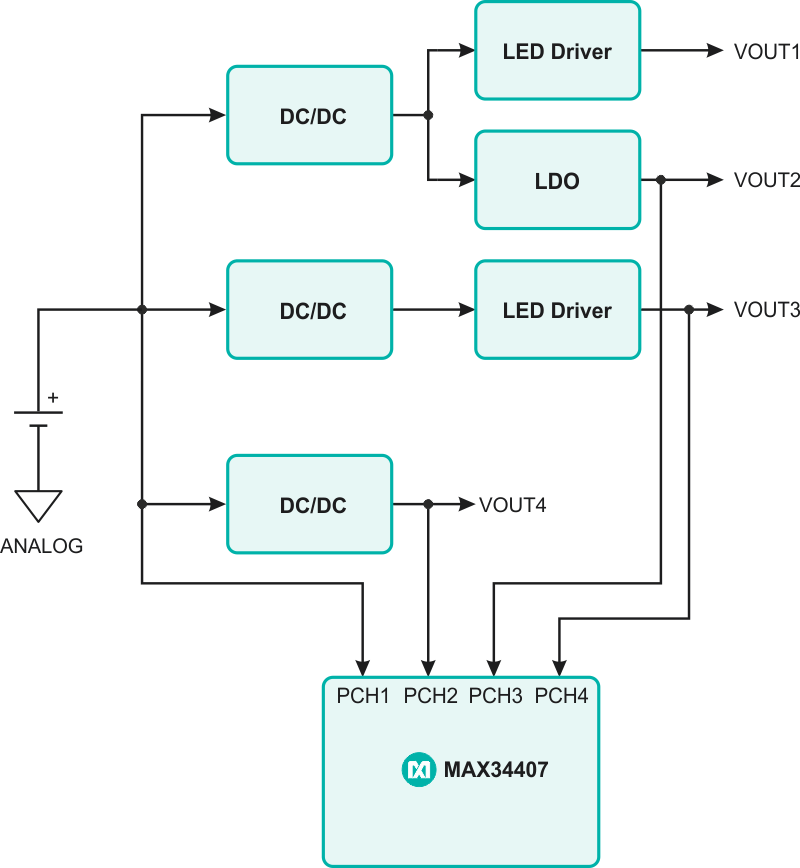 |
||
| Figure 7. | Board/System Power Monitoring. | |
A typical power system is shown in Figure 7 using MAX34407 to monitor critical system rails. This includes the input voltage rail to monitor the input power to the system. Furthermore, rails that consume the greatest power are monitored to determine system efficiency and provide protection to high-power outputs. It is important to note these converters may be remotely located, which requires extensive routing to MAX34407. MAX34407 must be properly routed to ensure switching noise does not impact power measurements. Layout considerations are covered in the layout section of this article.
Power Monitoring During Prototyping
In today’s market, high-speed development is crucial to competition; thus, solutions that are quick and easy to implement are becoming more desirable. Many developers use microcontroller platforms such as ARM® mbed™, Arduino, Raspberry Pi, etc. for rapid prototyping. These hardware platforms can be easily upgraded using add-on boards. These daughterboards provide additional hardware functions that cannot be accomplished using the hardware on the platform board itself. Power accumulation is a function that can be used to monitor a prototype’s performance with quick implementation.
A power accumulator add-on board allows for power measurements of any system rail during the development phase of a project. This provides an easy way to measure software efficiency, sensor efficiency, converter efficiency, or the general power consumption of any system block. Sense resistors and terminal blocks placed onto the add-on board can provide power measurements of individual modules. Alternatively, in-system sense resistors can be routed to a power accumulator add-on board instead of using the on-board sense resistors. Whatever the application may be, using a power accumulator provides valuable data during the design phase.
Layout and Filtering Considerations
Layout is crucial in any instrumentation application to minimize measurement error. Moreover, power monitoring requires component placement near switching converters, where switching interference will induce error on power measurement. It is extremely important to reduce coupled noise by proper routing. In cases where noise is inevitable, filters may be placed at the power monitor inputs to filter either common-mode noise or differential-mode noise. In an example of proper Kelvin sense connections placed across the current sense resistor, the two current sense lines would be of equal length and would be routed in parallel to each other with minimal spacing in between.
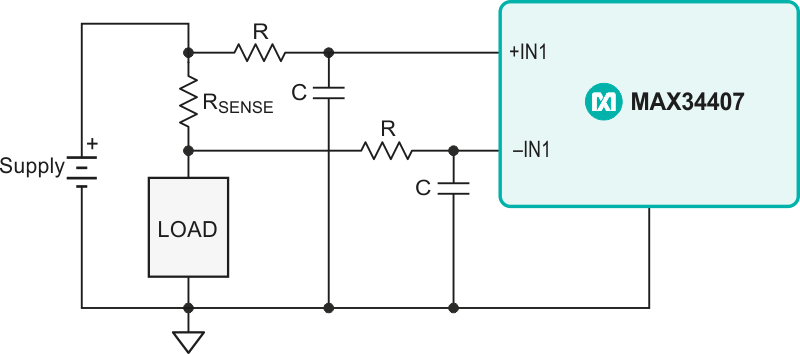 |
||
| Figure 8. | Common Mode Filter. | |
MAX34407 operates by taking high-side measurements, making it prone to common-mode noise. Additional filtering may be required if the system exhibits excessive common-mode noise. RC filters are placed in series with the current-sense input to filter the unwanted noise. Figure 8 demonstrates a common-mode filter configuration using two identical RC filters on each current-sense line. This effectively forms a low pass filter for common-mode signals. Since filter resistors are placed in series with the current-sense path, these resistors must be well matched to prevent offset in the power measurement. For this reason, filter resistors should be chosen to have 1% tolerance or less. In addition, the series filter resistor must be much less than the input impedance of the power accumulator to avoid loading effects. The poles of the filters are chosen to be far below the Nyquist sampling frequency of the accumulator. Below is the equation used to determine the pole of the common-mode filter:
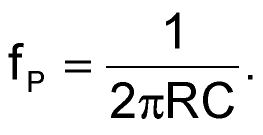
The input current of power supplies is quite noisy due to the internal switching of the power supply topology. This is presented as differential-mode noise to the power accumulator through the high-side current-sense resistor. Differential-mode noise can be attenuated by using a differential-mode filter, as shown in Figure 9. As previously discussed for the common-mode filter, the series resistors must be well matched and their resistances must be much larger than the input impedance of the power accumulator. The pole for the differential-mode filter is also selected to be less than the Nyquist frequency of the power accumulator. The two series resistors and capacitor produce a pole for the differential signal between the MAX34407 inputs (i.e. +IN1/-IN1). Below is the equation used to determine the pole of the differential-mode filter:
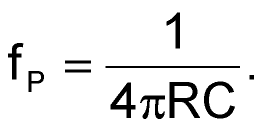
A twisted-wire pair is required for off-board connections to the power accumulator. This is the case for applications such as an mbed or Arduino shield where power measurement is performed remotely. In a typical configuration of a twisted-wire pair connected to the terminals of the current-sense resistor, the twisted-wire pair reduces the loop between the two current-sense wires, which effectively reduces coupling noise. In addition, the twisted pair provides differential-mode filtering through inductive coupling between the wires. Twisted-wire pairs are required for remote sensing of load power.
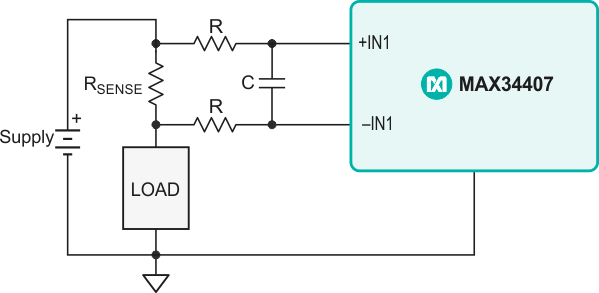 |
||
| Figure 9. | Differential Mode Filter. | |
Conclusion
Power accumulation is a desirable function in any system that requires protection or efficiency optimization. The applications discussed range from low-power to high-power systems, and in each case, there is a specific need to determine the power consumption from critical system rails. In addition, dedicated power accumulation hardware removes a significant amount of processor overhead that would be required with a traditional power monitor. Overall, these power accumulation devices provide telemetry of system blocks that empower the designer to make decisions based on power performance.